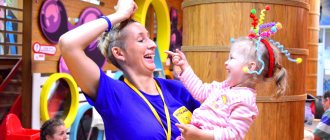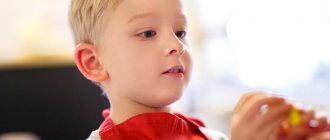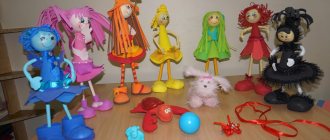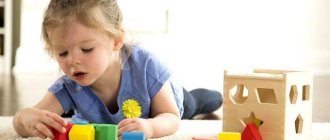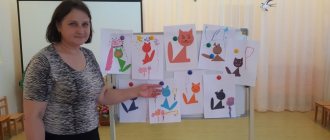Games and exercises for developing imagination in preschoolers aged 5–7 years
Elena Sergeeva
Games and exercises for developing imagination in preschoolers aged 5–7 years
Imagination is nothing more than a mental process through which a person gets the opportunity to draw new images based on existing life experience. Imagination allows a preschool child to find his place in the world, realize his existing abilities, and also contributes to the understanding of the school curriculum, that is, prepares the child for school.
Didactic games have been used for quite a long time as one of the effective means by which one can develop the imagination of a child in older preschool age.
Games and exercises for developing imagination in preschoolers 5 – 7 years old
1. Exercise “What do our palms ”
Goal: development of imagination and attention .
palm (or two) with paints or pencils.
and come up with, fantasize,
“What could this be?” (tree, birds, butterfly, etc.)
. Offer to create a drawing based on the circled palms.
2. Game - exercise “Three colors”
.
Goal: development of artistic perception and imagination .
Invite the children to take three colors that, in their opinion, are most suitable for each other, and fill the entire sheet with them in any way. What does the drawing look like?
3. Exercise “Magic Blots”
.
Goal: development of creative imagination ; learn to find similarities between images of unclear outlines and real images and objects.
Suggest that you drop any paint onto the middle of the sheet and fold the sheet in half. The result was various blots; children need to see in their blot what it looks like or who it resembles.
4. Exercise “Magic thread”
.
Goal: development of creative imagination ; learn to find similarities between images of unclear outlines and real images and objects.
In the presence of children, dip a thread 30-40 cm long in ink and place it on a sheet of paper, curling it randomly. Place another sheet on top of the thread and press it to the bottom one. Pull out the thread while holding the sheets. A trace of the thread will remain on the paper; children are asked to identify and name the resulting image.
5. Game – “Unfinished Drawing”
.
Goal: development of creative imagination .
Children are given sheets with images of unfinished objects. You are invited to complete the drawing of the object and talk about your drawing.
6. Exercise “Wizards”
.
Goal: development of emotionality and creative imagination .
Without a preliminary conversation, invite the children to use pencils to transform two completely identical figures depicted on the sheet into an evil and a good wizard. Next, ask them to come up with something bad that the “evil one”
the “good”
one defeated him .
7. Exercise “Dance”
.
Goal: development of emotionality and creative imagination .
Invite children to come up with their own image and dance it to certain music. The rest of the children must guess what image is intended.
Options - the image is set, all children dance at the same time ( “blooming flower”
,
“affectionate cat”
,
“snowfall”
,
“cheerful monkey”,
etc.).
Complication - to convey feelings in dance ( "joy"
,
“fear”
,
“surprise”
, etc.)
8. Exercise “What the music told you about”
.
Goal: development of creative imagination .
Classical music is playing. Children are asked to close their eyes and imagine what the music is saying, and then draw their ideas and talk about them.
9. Game “What is this?”
new images in their imagination based on the perception of substitute objects .
Circles of different colors and strips of different lengths are used. Children stand in a circle. The teacher shows one of the colored circles, puts it in the center and asks them to tell what it looks like. Answers should not repeat each other.
10. Game “Pebbles on the Shore”
.
Goal: to learn to create new images based on the perception of schematic images.
A large painting depicting a seashore is used. 7-10 pebbles of different shapes are drawn. Everyone should have a resemblance to some object, animal, person.
The teacher says: “A wizard walked along this shore and turned everything that was in his way into pebbles. You have to guess what was on the shore, say about each pebble, who or what it looks like.” It is desirable that several pebbles have almost the same contour. Next, invite the children to come up with a story about their pebble: how did it end up on the shore? What happened to him? Etc.
11. Exercise “Magic Mosaic”
.
Goal: to teach children to create objects in their imagination , based on a schematic representation of the details of these objects.
Sets of geometric shapes cut out of thick cardboard are used (the same for each child)
: several circles, squares, triangles, rectangles of different sizes.
The teacher hands out the kits and says that this is a magical mosaic from which you can put together a lot of interesting things. To do this, you need to attach different figures to each other as you wish so that you get some kind of image. Offer a competition: who can put together the most different objects from their mosaic and come up with some kind of story about one or more objects.
12. Game “Let’s Help the Artist”
.
Goal: to teach children to imagine objects based on the scheme given to them.
Material: a large sheet of paper attached to a board with a diagram of a person drawn on it. Colored pencils or paints.
The teacher says that one artist did not have time to finish the picture and asked the children to help him finish the picture. Together with the teacher, the children discuss what and what color is best to draw. The most interesting proposals are embodied in the picture. Gradually, the diagram is completed, turning into a drawing.
Then invite the children to come up with a story about the drawn person.
13. Game “Magic Pictures”
.
Goal: to teach to imagine objects and situations based on schematic images of individual parts of objects.
The children are given cards. Each card contains a schematic representation of some object details and geometric shapes. Each image is located on the card so that there is free space for finishing the picture. Children use colored pencils.
Children can turn each figure depicted on the card into the picture they want. To do this, you need to draw whatever you want to the figure. After finishing painting, children write stories based on their paintings.
14. Game “Wonderful transformations”
.
Goal: to teach children to create objects and situations in their imagination based on visual models.
The teacher gives the children pictures with images of substitute objects, each with three stripes of different lengths and three circles of different colors. Children are invited to look at the pictures, come up with what they mean, and draw the corresponding picture (several are possible)
The teacher analyzes the completed drawings together with the children: notes their correspondence to the depicted substitute objects (in shape, color, size, quantity, originality of content and composition.
15. Game “Wonderful Forest”
.
Goal: to teach how to create situations in your imagination based on their schematic representation.
Children are given identical sheets of paper, several trees are drawn on them, and unfinished, unformed images are located in different places. The teacher suggests drawing a forest full of miracles with colored pencils and telling a fairy tale about it. Unfinished images can be turned into real or imaginary objects.
For the assignment, you can use material on other topics: “The Wonderful Sea”
,
“Wonderful Glade”
,
“Wonderful Park”
and others.
16. Game "Changes"
.
Goal: to learn to create images of objects in the imagination based on the perception of schematic images of individual parts of these objects.
Children are given sets of 4 identical cards, on the cards there are abstract schematic images. Assignment for children: each card can be turned into any picture. Stick the card on a piece of paper and use colored pencils to draw whatever you want to create a picture. Then take another card, stick it on the next sheet, draw again, but on the other side of the card, that is, turn the figure into another picture. You can turn the card and sheet of paper over as you want while drawing! Thus, you can turn a card with the same figure into different pictures. The game lasts until all the children finish drawing the figures. Then the children talk about their drawings.
17. Game “Different Tales”
.
Goal: teach children to imagine various situations , using a visual model as a plan.
The teacher builds any sequence of images on the demonstration board (two standing men, two running men, three trees, a house, a bear, a fox, a princess, etc.) Children are asked to come up with a fairy tale based on the pictures, observing their sequence.
You can use various options: the child independently composes the entire fairy tale; the next child should not repeat its plot. If this is difficult for children, you can compose a fairy tale for everyone at the same time: the first one starts, the next one continues. Next, the images are swapped and a new fairy tale is composed.
18. Exercise “Come up with your own ending to the fairy tale”
.
Goal: development of creative imagination .
Invite children to change and create their own ending to familiar fairy tales.
“The bun didn’t sit on the fox’s tongue, but rolled on and met...”
.
“The wolf didn’t manage to eat the kids because...”
etc.
19. Game “Good and bad”
or
"Chain of Contradictions"
.
Goal: development of creative imagination by searching for contradictions.
The teacher starts - “A”
good, because
"B"
.
The child continues - “B”
is bad because
“B”
.
The next one says - “B”
is good because
“G”
, etc.
Example: walking is good because the sun is shining. The sun is shining - it’s bad because it’s hot. Hot is good because it’s summer, etc.
20. Game “Fairy-tale animal (plant)
».
Goal: development of creative imagination .
Invite children to come up with and draw a fantastic animal or plant that is not like the real thing. After drawing a picture, each child talks about what he drew and comes up with a name for what he drew. Other children look for features of real animals (plants)
.
21. Exercise “Fairy tale - story”
.
Goal: development of creative imagination , the ability to distinguish reality from fantasy.
After reading a fairy tale, children, with the help of a teacher, separate in it what can really happen from what is fantastic. It turns out two stories. One is completely fantastic, the other is completely real.
of similar games and exercises can be created, it all depends only on the creative imagination of adults who have set themselves the goal of helping every child grow up creatively gifted, out-of-the-box thinking, successful
personality.
conclusions
The modern world requires a person to be able to find non-standard solutions to problems. Already in elementary school, the child is faced with tasks that require a creative approach to successfully complete. Preschool age is considered the most favorable for the development of imagination. To do this, there are many games and exercises in which kids need to independently come up with something new and unusual. And don’t forget to set an example for your child, because children copy the behavior of adults: play and fantasize with your baby.
Varieties of Imagination
There are many types of this mental process. Let's briefly consider the main ones.
Active. Thanks to him, we have the ability to consciously evoke the necessary image. In turn, it is divided into:
- Creative - helps to create new images, which are later embodied in a painting, architectural work, music, clothing, etc. Without at least a remote idea of the future result of his work, a person will not start working. This type is also called productive, since the image created by our brain is later brought to life in the form of a painting, sculpture, song, clothing and much more.
- Recreating - allows you to again and again present a visual image of those things that we have already seen. This type is very important, since the information accumulated by it is the basis from which ideas for creativity are drawn.
Passive. It generates images and ideas that will not be brought to life by humans in the near future. May be conscious or unconscious.
- A dream is the ability of the human brain to generate images of the distant future, to plan things that, in general, can be accomplished, but not in the near future. Dreams manifest themselves consciously.
- Dreams. The main feature of this type of imagination is that the implementation of images created by the brain is impossible and unrealistic. They appear consciously.
- Hallucinations are the unconscious generation by the human brain of images that are unreal and non-existent. They appear in the event of a malfunction of the brain (for example, as a result of taking certain medications or mental illness). Their impact is so strong that a person has absolutely no doubt about their unreality.
- We see dreams at a time when our body is resting. They appear unconsciously.
Developing speech
Naturally, any person’s speech begins to develop from an early age, when children become familiar with their surroundings. However, it is still possible to help them. The main thing is to do it correctly so as not to harm the child.
There are three generally accepted ways of developing speech: visual, practical and verbal. In preschool organizations, a visual method is most often used, which consists in the teacher himself telling children about the world around them.
So, there is a direct version of this method, which involves visiting excursions or simply pointing at one or another object and pronouncing its name. Another option is indirect, which develops speech by describing certain images or toys. Thus, the skills of coherent speech are improved, and the vocabulary of children is consolidated.
Toys
Let's look at what kinds of toys there are that develop the imagination.
Lotto with pictures. When taking out a card with a certain image, invite your child to accompany the picture with an interesting, short story. When mom draws the next card, she must also describe the image with a short story. When your child masters this game, you can make it slightly more difficult. Now, when pulling out cards, you need to not only describe the image with a story, but also connect your story and the child’s with each other. Accordingly, the baby will have to continue the mother’s story, pulling out subsequent cards. Puppet show. Both finger toys and those that fit on the hand are suitable
It is important that the child can come up with a story using certain characters. If it’s difficult for a child to come up with a fairy tale right away, then for the first time you can do it instead. A construction set is a great toy that allows you to develop imagination and imagination.
To use this toy effectively, you should not use instructions when building it. There is a wide variety of designers. They come in plastic, metal, and wood. Let the child create using his imagination. Cubes. They are also great for developing imagination. Let your child come up with his own designs. If it’s still difficult for the little one, help. Children's kitchen, household appliances, doctor's kits - all this allows you to create role-playing games, developing the baby's imagination.
Varieties of Imagination
Imagination is involved in all types of human activity, but most often in creativity. Developed imagination, creativity and imaginative thinking are simply necessary for people in creative professions. But even people whose specific activity is far from free imagination have to deal with a considerable number of its types and forms every day, without noticing it.
Kinds
imagination:
- According to the results of the process:
- productive or creative, when the product of the imagination is a relative or absolute innovation;
- reproductive, when an object already existing in the world is recreated.
- By degree of activity:
- active, involving some effort of will;
- passive or involuntary, when the creative product is produced unintentionally and unpredictably.
- Depending on the mechanism of imagination:
- schematization - identifying similarities and smoothing out differences;
- agglutination - the connection in the mind of objects that are incompatible at first glance;
- hyperbolization – reduction or enlargement of an object or its parts;
- typification - identifying the main and recurring element in homogeneous phenomena.
Forms
imagination:
- A dream is a vision of the future, the time of which is not precisely defined.
- Fantasy is a largely modified reflection of reality.
- Dreams are a representation of the unattainable and unrealizable.
- Hallucinations are images that appear in the mind without an external stimulus.
- Dreams are a form of unconscious visualization.
Interesting fact!
Scientists were able to experimentally prove that in the process of imagining a certain event, all the same areas in the human brain are activated that are involved when the action is actually performed and not imagined. It turns out that for the brain there is no difference between the imaginary and the real.
